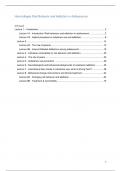College aantekeningen
Hoorcolleges Risk Behavior and Addiction in Adolescence
In dit document staan alle hoorcolleges van het vak Risk Behavior and Addiction beschreven. De aantekeningen zijn afwisselend in het Nederlands of Engels. De belangrijke begrippen zijn in het Engels genoteerd en waar nodig is er uitleg in het Nederlands toegevoegd.
[Meer zien]




